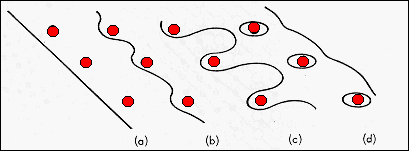| |
In thinking
about how the microstructure of metals and alloys influence dislocation
motion, and hence the mechanical properties of these materials, it is useful
to remember that the dislocation line has an elastic field associated with
it. This field can interact with interstitial or substitutional impurity atoms,
small second phase particles (as illustrated), grain boundaries between the
crystallites of normal polycrystalline technical materials, and with phase
boundaries and surfaces.
In designing a material to be tough and strong,
the creation of these barriers to dislocation motion is part of the material
scientists palette. In selecting a material based on its properties, care
must be taken that subsequent manufacturing processes do not change the number
of these barriers and give rise to much changed physical properties.
Manufacturing
processes such as bending, soldering, welding, and heat treatment
can all change the materials microstructure and hence its mechanical properties. |
| |
|
|
From: Barrett,
Nix, and Tetelman,
"The Principles of Engineering Materials,"
Prentice
Hall (1973) |
|
|
